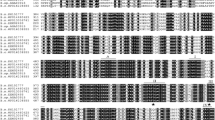Summary
A novel thermostable pullulanase, secreted by the thermophilic anaerobic bacterium Clostridium thermosulfurogenes EM1, was purified and characterized. Applying anion exchange chromatography and gel filtration the enzyme was purified 47-fold and had a specific activity of 200 units/mg. The molecular mass of this thermostable enzyme was determined to be 102 000 daltons and consisted of a single subunit. The enzyme was able to attack specifically the α-1,6-glycosidic linkages in pullulan and caused its complete hydrolysis to maltotriose. Surprisingly and unlike the enzyme from Klebsiella pneumoniae, the purified enzyme from this anaerobic thermophile exhibited, in addition to its debranching and pullulanase activity, an α-1,4 hydrolysing activity as well. By the action of this single polypeptide chain various branched and linear polysaccharides were completely converted to two major products, namely maltose and maltotriose. The K m values of this enzyme for pullulan and amylose were determined to be 1.33 mg/ml and 0.38 mg/ml, respectively. This debranching enzyme displays a temperature optimum at 60°–65° C and a pH optimum at 5.5–6.0. The application of this new class of pullulanase (pullulanase type II) in industry will significantly enhance the starch saccharification process.
Similar content being viewed by others
References
Abdullah M, French D (1970) Substrate specificity of pullulanase. Arch Biochem Biophys 137:483–493
Antranikian G, Herzberg C, Gottschalk G (1987) Production of thermostable α-amylase, pullulanase and α-glucosidase in continuous culture by a new Clostridium isolate. Appl Environ Microbiol 53:1668–1673
Bender H, Wallenfels K (1961) Untersuchungen an Pullulan. II. Spezifischer Abbau durch ein bakterielles Enzym. Biochem Z 334:79–95
Coleman RD, Yang S-S, McAlister MP (1987) Cloning of the debranching-enzyme gene from Thermoanaerobium brockii into Escherichia coli and Bacillus subtilis. J Bacteriol 169:4302–4307
Fogarty WM, Kelly CT (1979) Starch degrading enzymes of microbial origin. Prog Ind Microbiol 15:87–150
Gabriel O, Wang SF (1969) Determination of enzymatic activity in polyacrylamide gels. Anal Biochem 27:545–554
Herzberg C, Antranikian G (1986) Evidence for a unique pattern of citrate lyase inactivation in Clostridium sphenoides. Biochem Biophys Acta 871:107–120
Hyun HH, Zeikus JG (1985) General biochemical characterization of thermostable-pullulanase and glucoamylase from Clostridium thermohydrosulfuricum. Appl Environ Microbiol 49:1168–1173
Jensen BF, Norman BE (1984) Bacillus acidopullulyticus pullulanase: application and regulatory aspects for use in food industry. Proc Biochem 19:129–134
Koch R, Zablowski P, Antranikian G (1987) Highly active and thermostable amylases and pullulanases from various anaerobic thermophiles. Appl Microbiol Biotechnol 27:192–198
Kuriki T, Okada S, Imanaka T (1988) New type of pullulanase from Bacillus stearothermophilus and molecular cloning and expression of the gene in Bacillus subtilis. J Bacteriol 170:1554–1559
Laemmli LK (1970) Cleavage of structural proteins during the assembly of the head proteins of bacteriophage T4. Nature 227:680–695
Lowry OH, Rosebrough NJ, Farr AL, Randall RJ (1951) Protein measurement with the Folin phenol reagent. J Biol Chem 193:265–275
Madi E, Antranikian G (1989) Identification of a starch degrading anaerobic thermophile producing thermostable α-amylase and pullulanase. Appl Microbiol Biotechnol 30:422–425
Madi E, Antranikian G, Ohmiya K, Gottschalk G (1987) Thermostable amylolytic enzymes from a new Clostridium isolate. Appl Environ Microbiol 53:1661–1667
Martin RG, Ames BN (1961) A method for determining the sedimentation behavior of enzymes: application to protein mixtures. J Biol Chem 236:1372–1379
Melasniemi H (1987) Characterization of α-amylase and pullulanase activities of Clostridium thermohydrosulfuricum. Biochem J 246:193–197
Melasniemi H (1988) Purification and some properties of the extracellular α-amylase-pullulanase produced by Clostridium thermohydrosulfuricum. Biochem J 250:813–818
Morrissey JH (1981) Silver stain for proteins in polyacrylamide gels: a modified procedure with enhanced uniform sensitivity. Anal Biochem 117:307–319
Nakamura N, Sashihara N, Nagayama H, Horikoshi K (1989) Characterization of pullulanase and α-amylase activities of a Thermus sp. AMD33. Starch/Stärke 41:112–117
Ouchterlony Ö (1949) Antigenantibody reactions in gels. Acta Pathol Microbiol Scand 26:507–515
Plant AR, Morgan HW, Daniel RM (1986) A highly stable pullulanase from Thermus aquaticus YT-1. Enzyme Microb Technol 8:668–672
Plant AR, Clemens RM, Daniel RM, Morgan HW (1987) Purification and preliminary characterization of an extracellular pullulanase from Thermoanaerobium Tok6-B1. Appl Microbiol Biotechnol 26:427–433
Pugsley AP, Chapon C, Schwartz M (1986) Extracellular pullulanase of Klebsiella pneumoniae is a lipoprotein. J Bacteriol 166:1083–1088
Saha BC, Zeikus JG (1989) Novel highly thermostable pullulanase from thermophiles. Trends Biotechnol 7:234–239
Saha BC, Mathupala SP, Zeikus JG (1988) Purification and characterization of a highly thermostable novel pullulanase from Clostridium thermohydrosulfuricum. Biochem J 252:343–348
Sakano Y, Higuchi M, Kobayashi T (1972) Pullulan 4-glucan-hydrolase from Aspergillus niger. Arch Biochem Biophys 153:180–187
Schülein M, Hojer-Pedersen B (1984) Characterization of a new class of thermophilic pullulanases from Bacillus acidopullulyticus. Ann NY Acad Sci 434:271–274
Shimizu M, Kanno K, Tamura M, Suekane M (1978) Purification and some properties of a novel α-amylase produced by a strain of Thermoactinomyces vulgaris. Agric Biol Chem 42:1681–1688
Siegel LM, Monty KJ (1966) Determination of molecular weights and frictional ratios of proteins in impure systems by use of gel filtration and density gradient centrifugation. Application to crude preparations of sulfite and hydroxylamin reductases. Biochem Biophys Acta 112:346–362
Suzuki Y, Imai T (1985) Bacillus stearothermophilus KP 1064 pullulan hydrolase. Its assignment to a unique type of maltogenic α-amylase but neither pullulanase nor isopullulanase. Appl Microbiol Biotechnol 21:20–26
Takasaki Y (1987) Pullulanase-amylase complex enzyme from Bacillus subtilis. Agric Biol Chem 51:9–16
Wöber G (1976) Pullulanase is a characteristic of many Klebsiella species and functions in the degradation of starch. Eur J Appl Microbiol 3:71–80
Wöhner G, Wöber G (1978) Pullulanase, an enzyme of starch catabolism, is associated with the outer membrane of Klebsiella. Arch Microbiol 116:303–310
Author information
Authors and Affiliations
Additional information
Offprint requests to: G. Antranikian
Rights and permissions
About this article
Cite this article
Spreinat, A., Antranikian, G. Purification and properties of a thermostable pullulanase from Clostridium thermosulfurogenes EM1 which hydrolyses both α-1,6 and α-1,4-glycosidic linkages. Appl Microbiol Biotechnol 33, 511–518 (1990). https://doi.org/10.1007/BF00172543
Received:
Accepted:
Issue Date:
DOI: https://doi.org/10.1007/BF00172543




